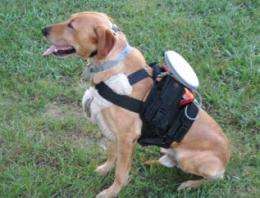Canine remote control

Man's best friend can get a bit tiresome, all that rolling over, shaking paws, long walks and eating every crumb of food off the floor. But, what if there were a way to command your dog with a remote control, or even via your smart phone…or even without hands?
Jeff Miller and David Bevly of the Department of Mechanical Engineering, at Auburn University, Auburn, Alabama, have devised just such a system and describe details in a forthcoming issue of the International Journal of Modelling, Identification and Control. The device based on a control suite with a microprocessor, wireless radio, GPS receiver, and an attitude and heading reference system provides autonomous guidance of the canine using an embedded command module with vibration and tone generation capabilities. Tests in a structure and non-structured environment show obedience accuracy up to almost 98%. It sounds like a boon for the lazy dog owner.
Of course, there is a serious side to the development of such a technology that allows dogs to be given commands remotely and for them to respond consistently. Dogs remain, for instance, the most accurate and sensitive mobile detection system for hidden explosives, people trapped after earthquakes and other disasters and in sniffing out drugs. However, the dog handler in such environments may not be able to safely access the place the dog can reach. Moreover, in a noisy environment or where the dog's hearing is compromised giving the necessary commands might also be impossible.
The team has demonstrated that a search & rescue or other working dog can be trained to respond "virtually flawlessly" to remote control tones and vibrations as if they were immediate commands from a human handler. "The ability to autonomously control a canine has far reaching," the team says. They also point out a similar system might be extended to a variety of applications allowing emergency responders to be guided remotely in hazardous situations such as a collapsing or burning building or for a haptic feedback GPS system to assist navigation by the visually impaired.
Of course, from this dog-owner's perspective, I can picture the scene: village pub, lazy Sunday afternoon, pint of beer in one hand, canine remote control in the other…
More information: Miller J. & Bevly D.M. (2013). A system for autonomous canine guidance, International Journal of Modelling, Identification and Control, 20 (1) 33. DOI: 10.1504/IJMIC.2013.055911
Provided by Inderscience Publishers




















